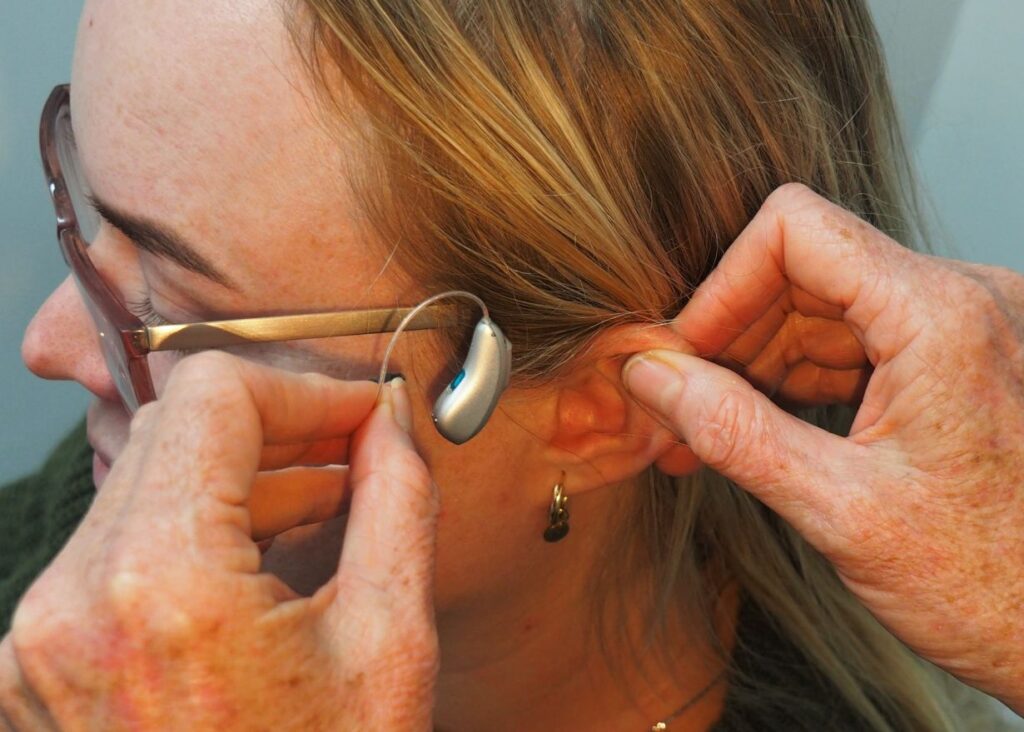There are several different types of hearing aids on the market.
Each type of hearing aid addresses a variety of hearing problems. Each comes with its own set of hearing care benefits and drawbacks.
In this article, we’ll discuss the four most common types.

We’ll also see how choosing hearing professionals with exceptional follow up care and selecting the right hearing center will improve your patient satisfaction experience and offer your better hearing for years to come.
The 4 best hearing aids types:
– Behind-the-ear
– In-the-ear
– In-the-canal
– Completely-in-the-canal.
As discussed earlier, one of the most important factors when going to a hearing center to buy a hearing aid, is finding one that fits your lifestyle and needs.
If you are active and participate in many different activities, you’ll want to be able to use them while you are active.
If you are hard of hearing, but still want to be able to hear in social situations, you’ll need a device with more amplification power.
When trying the different types, it’s important to get feedback from the hearing health care specialist about how the devices will work in different listening environments.
Treating hearing loss and getting noticeable better hearing may differ a lot depending on your surrounding.
For example, if you want to use them while you are watching TV, the hearing center specialist should test how well the TV sounds with the devices turned on.
So let’s dive into the 4 main types of hearing aids!
Type 1: “Behind-the-ear”
There are a few things you should keep in mind when shopping at a hearing center for behind-the-ear aids.
First, make sure the hearing aid is comfortable to wear. You don’t want something that’s going to be constantly slipping out of place or causing discomfort.
Second, consider the size of the hearing aid. You’ll need to make sure it’s not too bulky or obtrusive.
Type 2: “In-the-ear”
They’re one of the most popular types. They’re discreet and often more affordable than other types. “In-the-ear” come in a variety of styles, so you can find the perfect fit for your needs.
When evaluating the hearing center options for “in-the-ear” aids, there are a few things you should keep in mind for a better hearing experience.
First, consider the size. “In-the-ear” come in different sizes, so you’ll want to choose one that’s comfortable for you to wear.
You should also think about the type of battery you want. Some “in-the-ear” use disposable batteries, while others use rechargeable batteries.
Another thing to consider is the type of sound processing you want. “In-the-ear” come with a variety of features, so you can choose the one that’s right for you.
Some “in-the-ear” even have noise cancellation features, which can help reduce noise interference and background noise.
Others have feedback cancellation features, which can help prevent whistling and other unwanted sounds.
If you’re looking for a discreet hearing aid that’s comfortable to wear and has a variety of sound processing options, then “in-the-ear” are a great option.
Type 3: “In-the-canal”
There are a few things you should take into account when trying to decide if in-the-canal aids are right for you.
One is the size of your ear canal. If you have small ear canals, an “in-the-canal” will likely fit comfortably and securely. If you have larger ear canals, an “in-the-canal” may not be as comfortable or provide as good of a fit.
Another consideration is the level of your hearing loss.
If you have mild to moderate hearing loss, an “in-the-ear” may be appropriate for you.
If you have a more severe hearing loss, an “in-the-canal” may not be able to provide you with the amplification you need.
Finally, consider how much money you’re willing to spend. Depending on the hearing center, “in-the-canal” aids typically cost more than some other types, such as behind-the-ear or receiver-in-the-canal models.
Type 4: “Completely-in-the-canal”
Completely in-the-canal aids are the smallest, most discreet type of hearing aids. They fit completely in it and are virtually invisible to others.
Because they sit so deep in your ear, they’re also the most difficult type to remove and put back in. If you have difficulty using traditional ones, you may want to consider a completely “in-the-canal” model. In such cases too, a hearing professional at a licensed hearing center will know to guide you.
Also, keep in mind that completely “in-the-canal” aids are also the most expensive type. If budget is a concern, you may want to consider a different style of hearing aid.
However, if discreetness and superior sound quality are your top priorities, a completely “in-the-canal” hearing aid may be the best option for you.
If you’re considering a completely “in-the-canal” hearing aid, be sure to visit a reputable hearing center providing hearing healthcare with the most advanced technology, to get fitted for the right model.
There are many different types and brands of completely-in-the-canal aids, so it’s important to find the model that best suits your needs.
Conclusion
There are four main types of hearing aids:
in-the-ear (ITE), behind-the-ear (BTE), in-the-canal (ITC), and completely-in-the-canal (CIC).
Each type has its advantages and disadvantages, so it’s important to find the type that’s best suited for your individual needs.
Choosing the right type of hearing aid is key. Choosing a hearing professional at a local hearing center will also play a crucial role in your long-term care. The right type of hearing aid will help you hear better and make life easier.
You’re now better equipped with the knowledge you learned above.
Be sure to consult with hearing care professionals, get a hearing test (maybe even doing a home online hearing test first) to find the best ways to improve your hearing ability, and guarantee you better hearing for the rest of your life.
Final thoughts, make sure to check out recent articles and learn how much hearing aids cost. In a future post, we will review Over The Counter options.
Thanks for reading!


